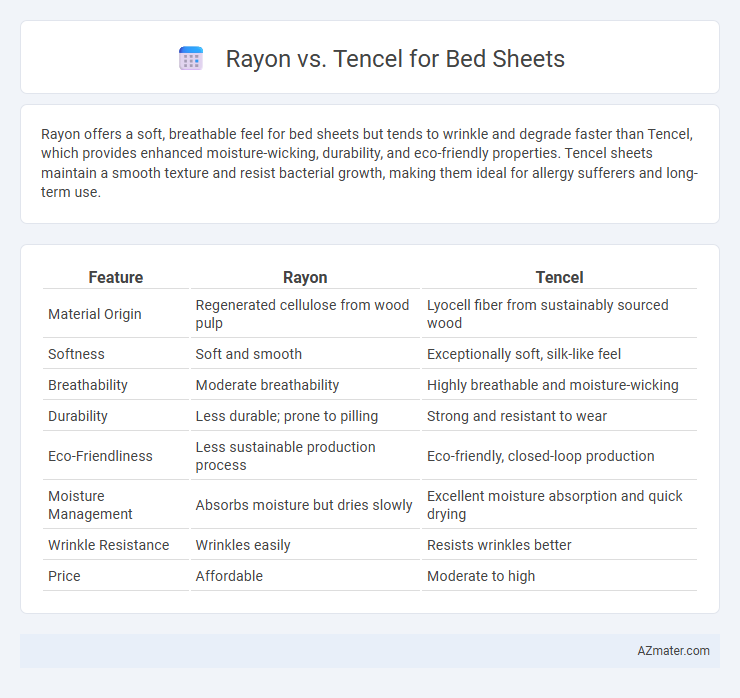Rayon offers a soft, breathable feel for bed sheets but tends to wrinkle and degrade faster than Tencel, which provides enhanced moisture-wicking, durability, and eco-friendly properties. Tencel sheets maintain a smooth texture and resist bacterial growth, making them ideal for allergy sufferers and long-term use.
Table of Comparison
| Feature | Rayon | Tencel |
|---|---|---|
| Material Origin | Regenerated cellulose from wood pulp | Lyocell fiber from sustainably sourced wood |
| Softness | Soft and smooth | Exceptionally soft, silk-like feel |
| Breathability | Moderate breathability | Highly breathable and moisture-wicking |
| Durability | Less durable; prone to pilling | Strong and resistant to wear |
| Eco-Friendliness | Less sustainable production process | Eco-friendly, closed-loop production |
| Moisture Management | Absorbs moisture but dries slowly | Excellent moisture absorption and quick drying |
| Wrinkle Resistance | Wrinkles easily | Resists wrinkles better |
| Price | Affordable | Moderate to high |
Introduction: Understanding Rayon and Tencel
Rayon and Tencel are both popular fibers used in bed sheets, derived from natural cellulose sources but processed differently. Rayon, made from wood pulp chemically treated to create a semi-synthetic fiber, offers a soft and breathable fabric that mimics cotton's comfort. Tencel, a branded form of lyocell produced through an eco-friendly closed-loop process, provides superior moisture-wicking, durability, and a smooth, silky feel ideal for premium bedding.
Origin and Production Processes
Rayon for bed sheets is derived from cellulose fibers typically sourced from wood pulp, undergoing a chemical-intensive process including steeping, pressing, and regeneration to transform the pulp into semi-synthetic fibers. Tencel, a branded form of lyocell, originates from sustainably harvested eucalyptus trees and is produced through a closed-loop process using non-toxic solvents that recycle water and chemicals, minimizing environmental impact. The key distinction lies in Tencel's eco-friendly production method, which results in a softer, more durable fiber compared to the traditional viscose-based rayon manufacturing.
Environmental Impact of Rayon vs Tencel
Tencel, a brand name for lyocell, is produced using a closed-loop process that recycles water and solvents, significantly reducing environmental pollution compared to traditional rayon manufacturing. Rayon production involves chemically intensive processes with carbon disulfide, causing higher levels of air and water pollution and greater resource consumption. Tencel's sustainable sourcing from sustainably managed eucalyptus forests and biodegradable fibers make it a more eco-friendly choice than conventional rayon for bed sheets.
Softness and Comfort Comparison
Tencel bed sheets offer superior softness and breathability compared to rayon due to their exceptional moisture-wicking properties and smooth fibers derived from sustainably sourced eucalyptus trees. Rayon sheets, while soft and smooth, often lack the durability and temperature regulation that Tencel provides, making Tencel more comfortable for sensitive skin and warmer climates. The natural fiber processing of Tencel results in hypoallergenic and breathable sheets, enhancing overall sleep comfort beyond what rayon can deliver.
Breathability and Temperature Regulation
Rayon and Tencel both offer excellent breathability, with Tencel providing superior moisture-wicking properties that enhance temperature regulation. Tencel fibers absorb moisture up to 50% more efficiently than rayon, promoting a cooler and drier sleep environment. Bedsheets made from Tencel are ideal for individuals seeking natural temperature management and comfort throughout the night.
Durability and Longevity
Rayon bed sheets, made from regenerated cellulose fibers, typically offer moderate durability but tend to weaken with frequent washing and prolonged use. Tencel, a branded form of lyocell, boasts superior strength and resilience due to its environmentally friendly production process and tightly packed fiber structure, resulting in longer-lasting bed sheets. Choosing Tencel sheets ensures enhanced longevity, resisting pilling and fading while maintaining softness over time.
Moisture-Wicking and Hypoallergenic Properties
Tencel bed sheets excel in moisture-wicking due to their lyocell fibers, which effectively absorb and release moisture, keeping sleepers cool and dry. Rayon sheets, while also moisture-absorbent, tend to retain more water, making them less efficient for moisture-wicking compared to Tencel. Hypoallergenic properties in Tencel reduce irritation and allergens, making it ideal for sensitive skin, whereas rayon, derived from wood pulp but with more chemical processing, may not be as gentle for allergy-prone users.
Care Instructions and Maintenance
Rayon bed sheets require gentle washing in cold water with mild detergent and should be air-dried to prevent shrinking and fabric damage, while avoiding bleach and high heat. Tencel sheets offer easier maintenance due to their resistance to wrinkles and shrinking; they can be machine washed in cold water on a gentle cycle and tumble dried on low heat without losing softness. Both materials benefit from avoiding fabric softeners to maintain their natural fibers and prolong the lifespan of the bed linens.
Price Differences and Value for Money
Rayon bed sheets are generally more affordable due to their lower manufacturing costs, making them a budget-friendly option for consumers seeking soft, breathable bedding. Tencel, a branded lyocell fabric derived from sustainably sourced eucalyptus trees, commands a higher price but offers superior moisture-wicking properties, durability, and eco-friendly benefits. While Rayon sheets provide decent comfort at a lower price point, Tencel sheets deliver greater long-term value through enhanced fabric strength, smoother texture, and better temperature regulation.
Which is Better: Rayon or Tencel for Bed Sheets?
Tencel bed sheets outperform rayon in durability, moisture-wicking, and breathability, making them ideal for a comfortable night's sleep. Derived from sustainably sourced eucalyptus fibers, Tencel offers natural hypoallergenic properties and a silky smooth texture, whereas rayon tends to be less eco-friendly and prone to wrinkles. Choosing Tencel ensures superior softness, enhanced moisture management, and long-lasting quality, positioning it as the better option for bed sheet materials.

Infographic: Rayon vs Tencel for Bed Sheet
 azmater.com
azmater.com